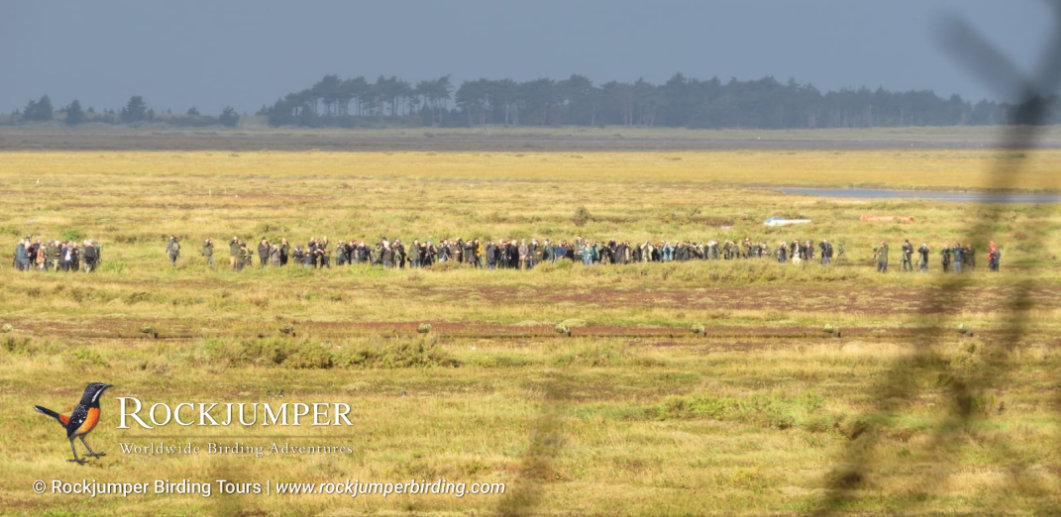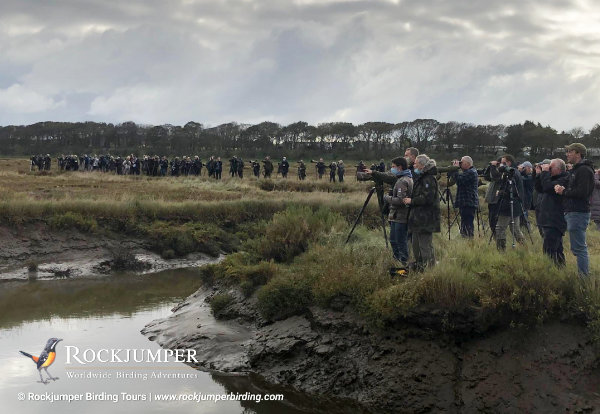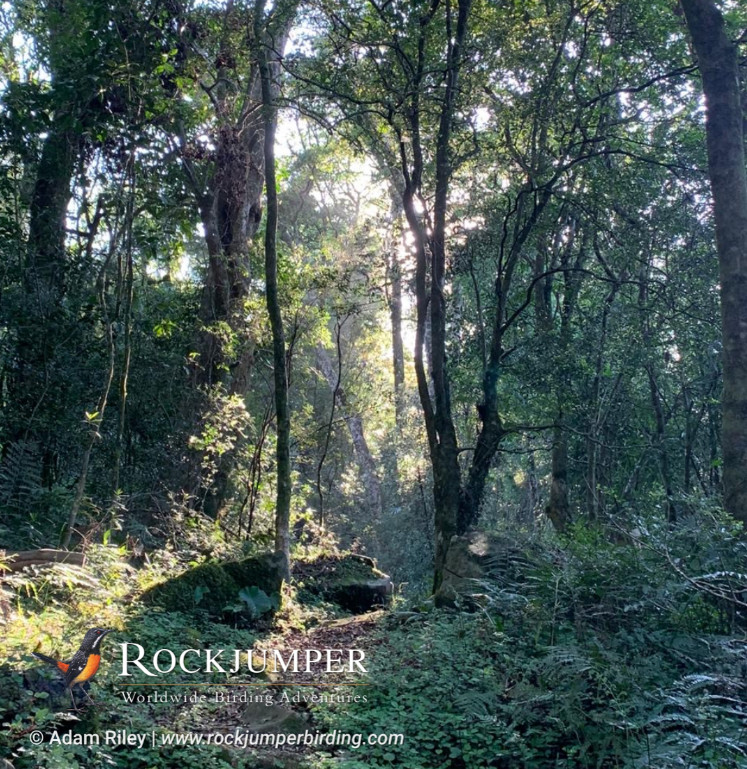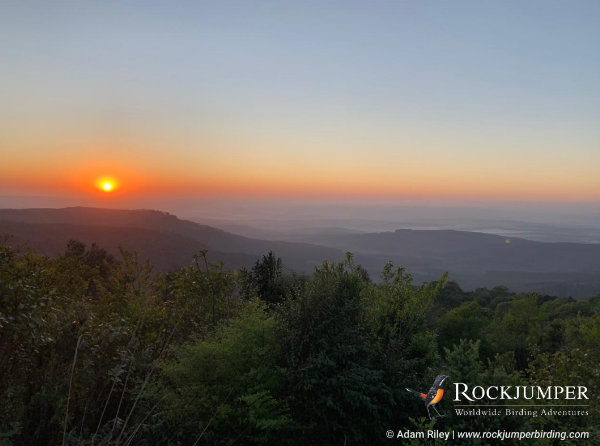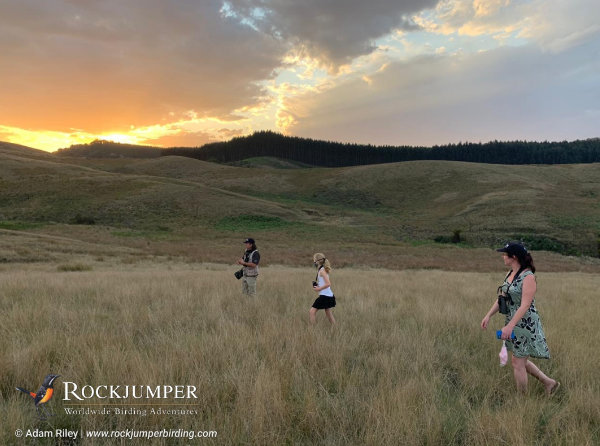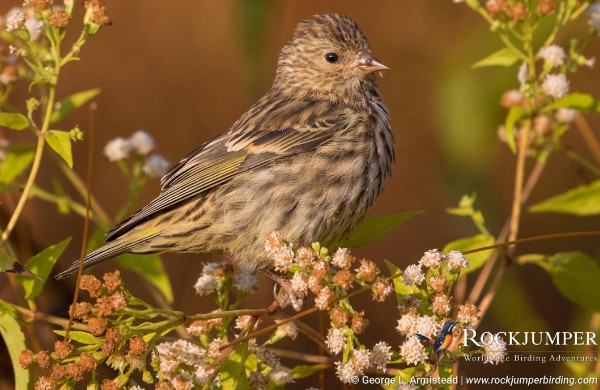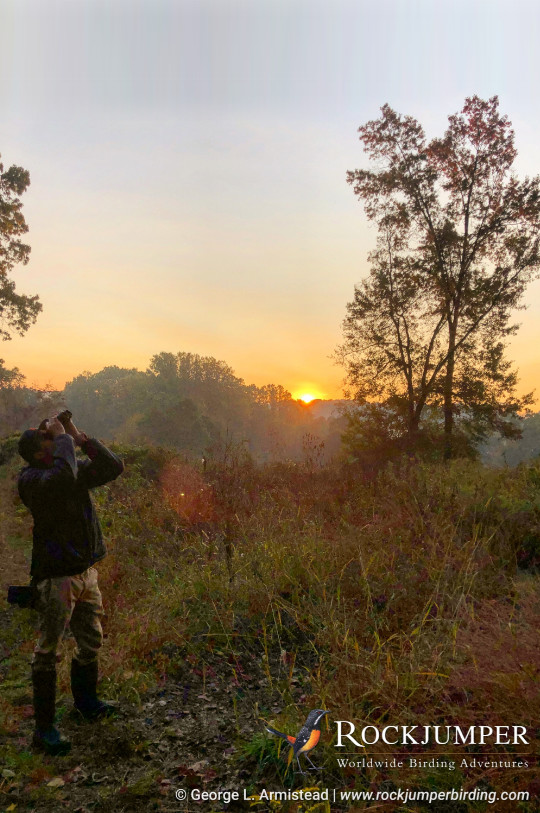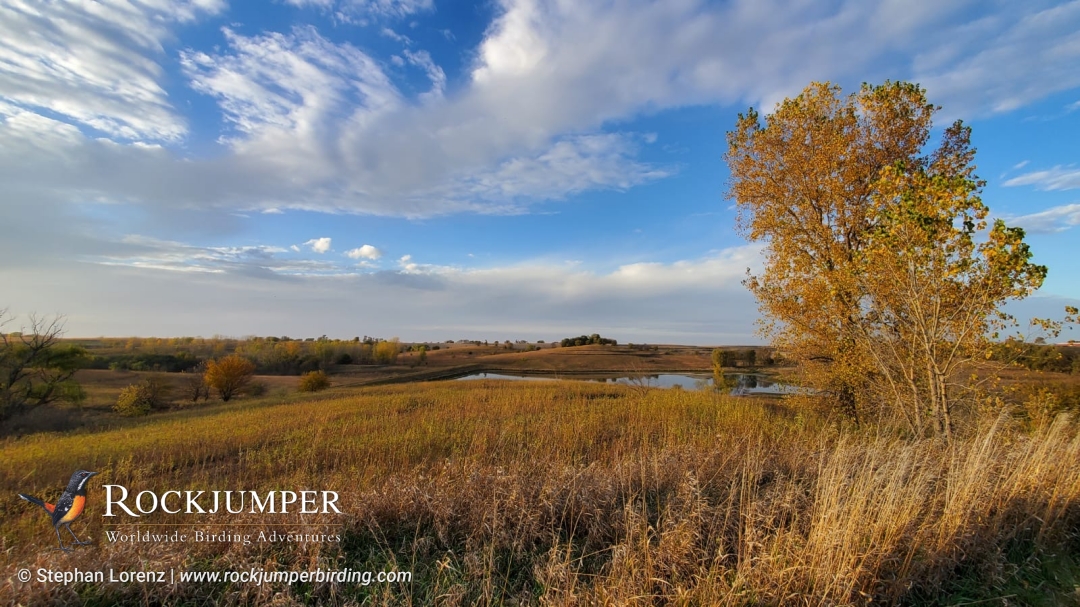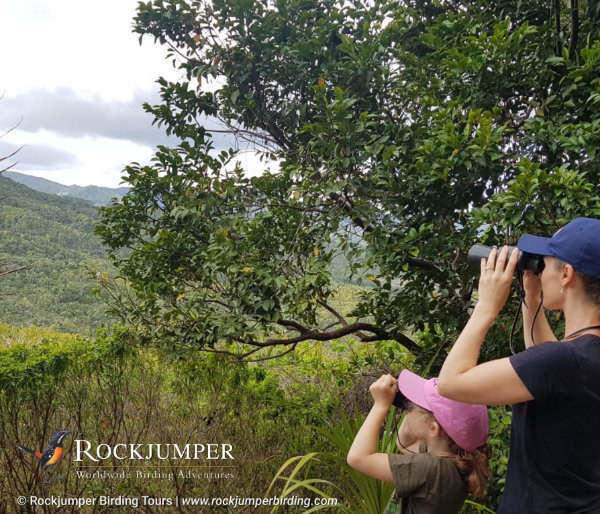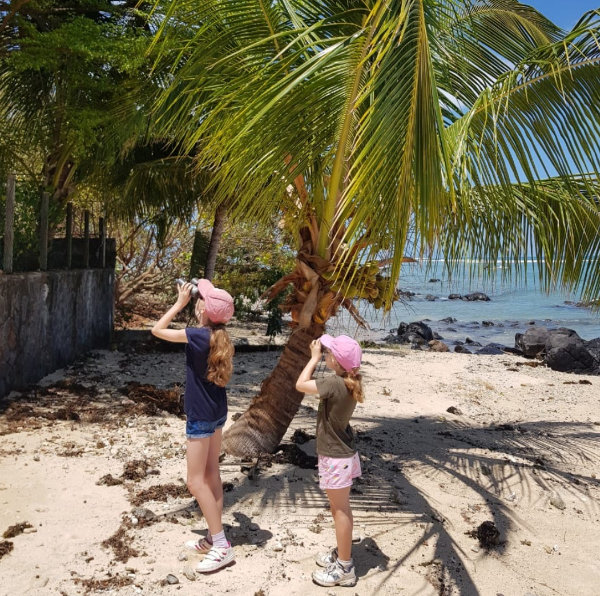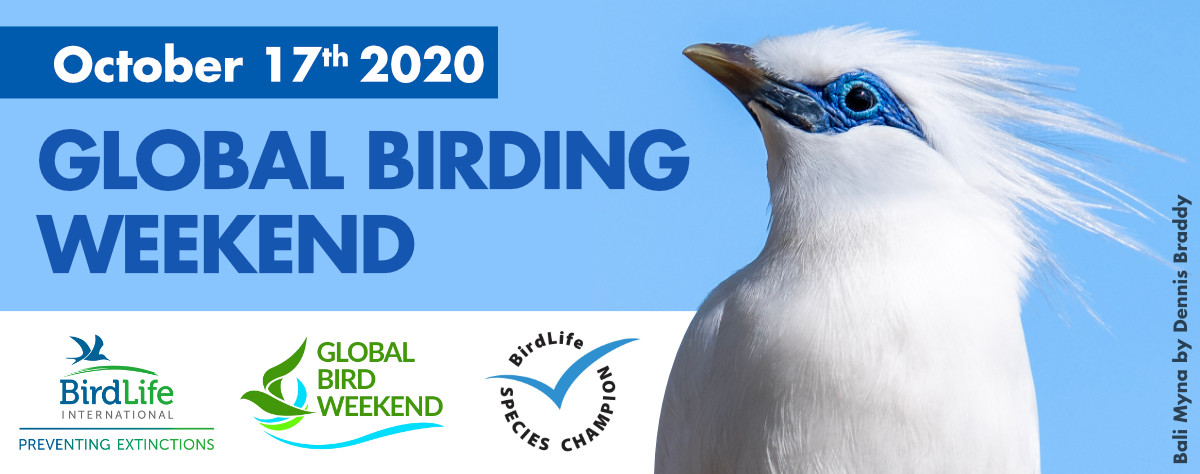
Indeed, 2020 has seen many “firsts” (some less pleasant than others!), but one we will all remember with fondness was the Global Bird Weekend, and in particular, the Global Big Day on October 17th.
The brainchild of Tim Appleton and a partnership with BirdLife International and the Cornell Lab of Ornithology’s Project eBird, the goal of the Global Bird Weekend is to get as many people birding around the world at once as possible, while also raising funds and awareness to fight the illegal bird trade. As our friend at BirdLife International Alex Dale points out, in parts of Asia there are more birds in cages than there are in the forests. Many birds face intense pressure from illegal capture and sale, and so this event was a thrilling way to try and fight for our cherished feathered friends.
Team Rockjumper took up this challenge and ran with it. The first step was to set up personal eBird accounts, at least for those of us who’d not used the platform before. While some of us here have been avid eBird users for years, for others this was a brand-new endeavor. Rockjumper leader Peter Kaestner has entered more species of birds into eBird than anyone else in the world, with well over 9000 species now. And while no one else quite reaches those lofty heights, Stephan Lorenz has eBirded more bird species over the last 3 years than anyone else during that period. Forrest Rowland also has featured in the top 10 annual list in recent years, and several others on the Rockjumper squad are avid eBird users and even volunteer as reviewers for the 20+ year project. The dataset is immense, impressive, and dynamic.
Of course, all of us were wondering how many species we might tally for the cause. Just how many birds could we see? If we got our whole team and recruited as many friends as we could, what would our number be? So, when the day finally arrived our team of 85+ got out into the field for the day, spreading across the globe in 17 countries and tallied a staggering 1852 species. As it turned out, our total would be the highest total of any team in the event! While our chief goal is to support the critical work at BirdLife International, the competitors within us did want to throw our best effort at getting the top species total. We certainly didn’t expect to win that prize, but we hoped we’d contend, and so it was a thrill to come out 800+ species ahead of the next closest team. Just imagine if we’d actually had tours out and operating as we would in a “normal October”! Team Rockjumper’s leader for the Global Bird Weekend, Meg Taylor stated, “1852 species without even leaving home… Imagine what we might do next year!” We look forward to improving on our total next year and expect it will surely be even more competitive in 2021.
Rockjumper was proud to put up a free spot on our cruise, Flock to Marion, as one of the top prizes for the event, and we are also thankful to our friends at Zeiss Sport Optics who put up a pair of their new, spectacular x32 Victory SFs as another prize. We continue to take donations until the end of the month. Please kick in what you can as we support BirdLife International’s initiative during a particularly trying time. To think, an entire worldwide pandemic that’s gripped us for the better part of a year might have been prevented had folks better respected nature and wild animals. You can still make a difference right now, with a donation.
To see some of the day’s highlights, have a look below. Thanks so much to all of you who participated and already donated. Together we really made it a remarkable day, and we did some good.
TEAM ROCKJUMPER
Whitney Lanfranco in Ocean Shores, Washington, USA
Although most Big Days involve finding as many species as possible, to participate with Team Rockjumper I decided my best bet in Washington was to go for quality vs. quantity. I headed to the Pacific coastal town of Ocean Shores to see what was birds I could find at the jetties. I knew I had made the right choice when a Western Grebe flew over me while I was getting out of the car. More grebes were floating on the waves, and Black Turnstones were scurrying around on the rocks. A few quick scans added Surf Scoter, several gull species, and Pacific Loon to my list. Afterward, I headed to Gray’s Harbor NWR, where a large amount of the North American population of American Wigeon are apparently wintering, but there were plenty of other species as well. It was a beautiful fall day to be out birding in the PNW but the most fun was being on a team with so many talented birders and hearing their many updates throughout the day!
Paul Varney in Norfolk, England
I should be so lucky, lucky, lucky, lucky!
So, the weekend of October 17th/18th was the Global Bird Weekend when teams around the world would aim to break the world record for the most bird species seen on one day and the number of people taking part. I was part of #TeamRockjumper and the night before was working out where to go – October in Norfolk after some easterlies had thrown up a few options. I perused the options and decided Stiffkey campsite seemed a one – a walk through the woods where some Pallas’s Warblers had been seen would be a good start. My brother-in-law Paul Willis was coming with me and I picked him up at 6.30am to arrive early at the coast.
En route we encountered 2 super Barn Owls, one very obligingly staying on the road sign as we pulled up right alongside it – that’s a good omen Paul said!
We arrived at Stiffkey Campsite right down by the saltmarsh to see something you don’t see so often – the spring tide was huge, and the sea was literally lapping the edge of the carpark.
We sorted ourselves out and walked maybe 20 yards where John Reeves was stood watching something on the footpath on the north side of the woods – the sea was actually covering the path 20 yards from where we were standing so we couldn’t walk along the seaward side anyway.The light still wasn’t brilliant when John said, “I’ve got something a bit strange on the path – just near the end” and he described where it was. I raised my bins and saw a pale, strange looking bird. John had seen it move across the path and said it had a rufous tail but it was partly obscured, and I couldn’t see the tail – just a pale, grey buff bird with a darker eyeline and quite strange pointed bill. Rufous tail implies Nightingale or a Redstart, but it was all wrong, shape, color, and face markings but I couldn’t place it just through my bins. It moved into the sueda and I saw the flash of a rufous tail – not the right colour for a redstart either. It ran across the path – John had asked if anyone had a camera and I was getting mine out but before I could, it then went into the sueda and disappeared for a few minutes. John then mentioned he thought it may be a Bushchat. Wooooaaah – that is rare!! It then skirted around the edge in flight closer to us, eventually popping up nearer the top. Now we could all see the pale super and the tail more clearly; John had been right, and it was a Bushchat. I mentioned to PW how rare this was and that for everyone this would be a new bird. Birders that had arrived at the car park at the right time had joined the three of us to hear this amazing news and John had already put the news out. The first few birders – the Cley residents and those that had already started to walk the campsite woods joined us announcing that the pagers were working and we all focused on a tiny bit of sueda that the bird had snuck into. It is difficult to remember the details but over the next 20-30 minutes birders started arriving at a pace and the bird got a bit flighty. Nobody was pushing it or approaching it but it just darted out of the sueda flashing that floppy gaudy tail and dived into the scrub at the edge of the car park before quickly relocating to the hedge line a hundred yards or so west. Perhaps 50 or so birders were present now and it was located at the edge of the field just at the base of the hedge line where we managed to get scope views of this absolutely amazing find. The tide was still high, so the saltmarsh was largely flooded still so when again after 15 minutes or so when the bird flew distantly out on to the marsh my first thought was well that is that then. It appeared to land in a patch of sueda, but the saltmarsh was basically sea with a couple of islands of vegetation. Getting out there just now was going to be tricky. We had seen it several times, mostly fairly briefly but had obtained reasonable views – it was a Rufous Bushchat (in old money) a Rufous Scrub Robin, a Rufous-tailed Scrub Robin – so many names but this was in Norfolk, this was in the UK and this was huge! Everybody needed this bird in the UK, everybody! Wasn’t aware until later in the day that the last twitchable bird was 1963!
So, the bird. When we first saw it, it was pretty sad looking. It was a little dingy and I only got it in my bins at perhaps 20-30 yards distance tucked under some sueda. It was a little larger that a Redstart and paler overall, especially on the upperparts which were cold grey brown, pale buff below and it had a clearly darker eyeline given it the wrong facial expression for a Redstart. The bill was spiky and pointed – again not so soft looking like a Redstart. The wings were a little darker than the upperparts and fringed paler. It was looking a little sad and tired but when it flew short distances the long – (longer than a redstart) orange rufous tail which was quite broad/fanned was a striking feature on an otherwise pale bird. I had only ever seen Bushchat in Lesvos and I recall initially being actually quite disappointed by it until it raised its tail which turned into something altogether much more impressive, this bird was similar but it looked fairly worn with spiky tail feathers and seemingly worn plumage – borne out by later views and photos.
When viewed in the field edge, the views were better and, in the scope, but I never saw it do the classic Bushchat raised tail pose. The pale supercilium was more obvious as the light improved.
Once it had flown out on to the marsh, John, Paul, and I myself decided to go do some birding – you never know, we may find something! By now people were arriving all the time and desperate for info but all we knew was that it had flown way out on the flooded marsh. Off we went and exchanged details before seeing some cracking Pallas’s Warbler(s), 1 perhaps 2. Not a bad day so far.
As we walked back, news was coming through that the hordes had relocated it and we saw a large crowd assembled out on the marsh – it transpires that they traipsed out there, while it was still flooded – some to serious personal cost (you can’t see the ditches and hollows when the tide is still in) – and found it in a patch of taller sueda – an island which became its favored locality for the next couple of days. The tide was out now so Paul and I donned appropriate footwear and joined the swelling crowd now enjoying occasional but decent views of the mega rarity. Everyone saw it that day and it was present the next day (saw it again – in better light and much more obliging) and on Monday, it is still present.
Paul and I were lucky. Lucky to choose Stiffkey, lucky we turned around and went back for the perched Barn Owl, lucky we bumped into John – sometimes you just get……lucky! Great that everyone saw it and the bird was not harassed.
We continued the Global Bird day adding such rare delights as Red-flanked Bluetail, Yellow-browed Warbler and newly arrived migrants in the form of Redwing, Fieldfare, Woodcock and Brambling. Bird migration is amazing and special thing to witness.
Team Rockjumper collectively saw nearly 1800 species globally and on Saturday nearly 7000 species were seen by the teams – all in aid of raising money for Birdlife to continue the fight against the wild bird trade. The Rufous Bushchat (sorry still can’t help that) amended a few Global Bird Weekend plans but it was still a huge success.
Heinz Ortmann – Pilanesberg National Park, South Africa
I was rather fortunate to be able to spend the entire weekend in Pilanesberg National Park about an hour’s drive north west of Johannesburg. The weekend preceded an intense heat wave, but we still experienced temperatures of 39C on Saturday and an even hotter 42C on Sunday. I spent most of Saturday doing some relaxed birding in the park and was pleasantly surprised with how much we encountered.
The early morning chorus included Coqui Francolin and a noisy mob of White-browed Sparrow-Weavers nesting in the Acacia tortilis trees above our tent. Several species alarm calls alerted me to the presence of the diminutive Pearl-spotted Owlet which didn’t hang around long before being mobbed further by Fork-tailed Drongos that had no interest in this little owl’s presence. Once in the park we enjoyed a few Kalahari or dry arid specials that included Violet-eared Waxbill, the gaudy, Crimson-breasted Shrike and Kalahari Scrub Robin amongst others. Green-winged Pytilia, Golden-breasted Bunting, Burnt-necked Eremomela, Blue Waxbill and Capped Wheatear were just some of the more widespread ‘bushveld’ birds that we came across. Other notable highlights included a single White-backed Vulture which is quite rare in the area, a wonderful sighting of the world’s heaviest flying bird the Kori Bustard and a several minutes long observation of a female Short-toed Rock Thrush catching and devouring a young Striped Skink! Not too bad for an intensely hot day toward the end of what has been a prolonged and difficult dry season in these parts.
Of course, no visit to a national park in Africa is without large mammals and we were certainly spoilt in between the many avian specials throughout the day. African Elephant, several White Rhino (all of which were recently de-horned to try and deter further poaching) and the good fortune of finding two large male Lions added to what was a super day. I certainly enjoyed this Global Birding Weekend very much and look forward to the next one.
Adam Riley at Mbona, South Africa
Yesterday was the Global Bird Challenge with people all around the world trying to see as many bird species as possible and raise money for BirdLife International’s conservation work. I decided to see how many birds I could find on Mbona in one day and set myself the goal of 120. Woke at 4:30 to howling winds… (if only it could have been same weather as this morning!). I headed to the forests and did the Inchebe-zebra loop recording very little due to the high winds. Then Guy’s Trail where I found one sheltered corner where the birds were really active, but almost nothing in the grasslands. By the time I came back to the car it was 39’C, not ideal weather but at least the wind began dying down. I then drove around to Crystal and Evergreen, took a few hours off then visited Pateric and Emerald where it started raining of all things! But at least it cooled down before I walked the grasslands on Little Mbona and finished at 9pm listening to Wood Owl and Tree Hyraxes on Holbeck. I ended on 108 species but reckon if weather was better, I could have made 120. This morning the first birds I saw when I got up were 3 species I didn’t find yesterday (House Martin and Little and African Black Swifts drinking from Laughter!) I even missed such regulars as Fish Eagle and Woolly-necked Stork. The absolute highlight for me was seeing a pair of Crested Guineafowl on Guy’s Trail, a Karkloof bird I have been searching for for over 30 years! Other great records included Striped Flufftail and Black-rumped Buttonquail on Little Mbona, Purple Heron on Rainbow, Emerald Cuckoo, 3 Narina Trogons, Grey Cuckooshrike, Bush Blackcap, Orange Ground Thrush, and great views of a pair of African Rail on Laughter. Several good mammals too including a Caracal near Evergreen. A fun day for sure!
George Armistead in Philadelphia, Pennsylvania, USA dd
In the days before the Global Birding Weekend and particularly the 17th, I was keeping a close eye on the weather. Several days of mediocre weather appeared soon to break with a cold front from the northwest, which is usually a fine recipe indeed for a good autumn migration day.
My day would be quite different from many of my colleagues, as I tried to squeeze any birds, I could find out of the few pockets of greenspace that the city of Philadelphia affords as cover to passing migrant birds. One thing I knew I could count on were Purple Finches and Pine Siskins. Both species are irrupting this fall in 2020, and siskins in particular are doing so on an unbelievable scale. I began with my Philly birding friends Liam and Gavin, at Lardner’s Point Park, and straight away siskins could be heard calling. Then a Purple Finch rose and re-landed nearby, giving its metallic “tip” call note in quick succession. Soon we heard others. Frost coated the grass, and a Winter Wren’s double noted scold could be heard in the brisk air. A stroll along the bike path here, which parallels the Delaware River, soon revealed decent numbers of sparrows including Lincoln’s Sparrows and a couple of juvenile White-crowneds as well. The clear highlight here, however, was a big female Peregrine Falcon that winged in carrying a large, heavy prey item. From its perch atop a power pole we could not determine what the prey was, but we could see feathers flying everywhere, like a trail of white confetti, streaming down into the river. After tallying an Eastern Meadowlark, a new species for this eBird hotspot, we moved upriver to Pennypack on the Delaware. There sparrows and raptors continued as a theme with several adult Bald Eagles soaring around, and a Vesper Sparrow emerged, along with loads more siskins.
I wrapped up the day at Philly’s best known eBird hotspot, Heinz National Wildlife Refuge. When I arrived two Merlins tussled in the snags over Darby Creek, while a Pterodactyl-like Caspian Tern hunted fish, and several Yellow-bellied Sapsuckers rumbled past, moving south. All in all, it was a pretty good haul. Can’t wait for the next one!
Erik Forsyth, Eastern Bay of Plenty, New Zealand.
Having a sure birding route planned a few weeks before the Global Birding Big day with 65 odd species possible, I suddenly found my planned route had to be changed the day before, as my son was taking part in a mountain bike competition in Rotorua (and I would be driving him there!)
A quick look at maps and a brief knowledge of the area, I put together a new route which might add more species. I started the day at 05:00am, walking across the road from the house to the edge of a forest. Here I quickly picked up the calls of a Morepork a resident owl species although the resident North Island Kiwi refused to call. Before dawn broke many Tui and New Zealand Bellbird were calling and soon afterwards Eurasian Blackbird, Silver-eye and best of all a North Island Robin was singing down in a dark gully. We then loaded up and drove to Rotorua picking up groups of Masked Lapwing, hordes of Black Swan and Australian Magpie en route.
No sooner had I dropped my son off and I was heading for a patch of forest half an hour away. On arrival I was nervously excited about what I might add to the list. After an hours walk, I had recorded 2 pairs of the very rare North Island Kokako, bouncing from branch to branch in large, moss infested Rimu trees (only 2500 birds remaining in the North Island in total), Singing Gray Warbler, Whitehead, irredescent plumaged Shining Bronze Cuckoo, Tomtit and the large New Zealand Pigeon. The middle of the day was slow although the drive back home through the lakes area produced Silver and Kelp Gulls, Swamp Harrier, Eurasian Coot, Australasian Shoveler and New Zealand Scaup. In the late afternoon, I headed to Ohiwa Harbour, where the tide was out but finding a small channel I quickly added large numbers of Bar-tailed Godwit, four Royal Spoonbill, Caspian Tern, Gray Teal, several pairs of New Zealand and a lone Double-banded Plover. And so, ended a frilling the day with a bbq and a wine at the end.
I ended the day with 56 species, which was satisfactory and fun despite the change of route, a few easy one’s missed, but most of I know this will help to aid a most worthy cause in stopping the illegal bird trade which is decimating birdlife in forests around the globe.
Peter Kaestner in Baltimore, Maryland, USA
A strong cold front that moved through Maryland on Friday, October 16 set the scene for the Global Big Day in Baltimore. The morning dawned bright and COLD, with widespread frost ensuring that my toes were frozen for the first couple of hours of the day. I started off in my local patch, Oregon Ridge Park, which is just a couple of miles from home. The main results of the front were that there were fewer neotropical migrant warblers around and the number of sparrows (especially White-throated) went up. One of the great spots at Oregon Ridge is the “Warbler Wall,” which catches the early morning sun’s rays. During September, the wall often was alive with warblers, but this cold morning, it was eerily still. Finally, I did spot a larger bird fly in — which turned out to be a late Rose-breasted Grosbeak. A rarity to start the day. Out in the meadow, I surprised an immature Tennessee Warbler, finally a Neotropical migrant. After a full two hours and just 39 species, I headed for my next stop — but not after stopping at home for some warmer socks! My next stop was the Paper Mill Flats, another local patch, that has hosted some good birds this fall, including White Ibis, Long-billed Dowitchers, and Hudsonian Godwit. Sadly, all the rarities had disappeared, and on two species of yellowlegs persisted. They had been joined by a couple of delightful Bonaparte’s Gulls and a gaggle of Black Ducks (including one Mallard hybrid). Another miss was a Northern Waterthrush that had been around the last couple of weeks. Paper Mill Flats is a part of Loch Raven Reservoir, one of Baltimore’s largest sources of drinking water, so I continued to two other birding sites alone the lake. I stopped quickly along a bridge over the center of the lake and found my only Common Loons and several Pied-billed Grebes. Then, I moved over to a skeet and trap shooting area and birding down to the water’s edge. There were lots of birds in the open, cut-over forest habitat. Several avian highlights included many newly arrived Purple Finches, five species of waterfowl on the lake, a Blue-headed Vireo, and a beautiful Magnolia Warbler. Since it was in the middle of the day, I headed towards the western shore of the Chesapeake Bay, one of the largest estuaries in North America. At North Point State Park birds were a bit scarce since it was sunny and calm. The usual gulls and Caspian Tern showed up, but I did not see a single duck on the bay. I did run into a nice flock of Yellow-rumped Warblers (“butter butts”), which winter commonly in southern and eastern Maryland. I did finally dig up a couple of goodies including a female Black-throated Blue Warbler and a couple more Blue-headed Vireos before heading to my last two stops. With 76 species recorded, I only needed four birds to get to a nice, round, 80 species for the day. I dropped off at Fort Howard but did not score any day birds. My last destination was Cromwell Valley Park, another good place for migrants not too far from home. I was desperate to get the last four, as the sun started to dip behind the hill. My first new bird was a nice Lincoln’s Sparrow that I had dipped at Oregon Ridge first thing in the morning. Then I spied a female House Sparrow feeding in the goldenrod along with a bunch of Song Sparrows. Then a flock of blackbirds passed over — Brown-headed Cowbird! Only one to go. There were still several possibilities including House Wren and Red-breasted Nuthatch, so I wandered over to the nature center that had some feeders. By this time, the sun had slipped behind the hill and the evening gloom had descended on the reserve. A half-dozen White-breasted Nuthatches were buzzing around the feeders, buoying my hopes that a Red-breasted Nuthatch could be nearby. All of a sudden, I caught a movement in the Silver Maple tree above me, and I quickly realized that the bird was a vireo — and it was not a Blue-headed Vireo, the only species of vireo expected at this late date. I got my camera on it and got a photo that shows that it was a Red-eyed Vireo that should be in Northern South America by now. The best bird of the day – and number 80!
Crystal Brook
Lev Frid
Stephan Lorenz in Montgomery County, Iowa, USA
For the Global Big Day on October 17th 2020, I intended to bird several hotspots in Montgomery County, Iowa. This area does not see much traffic by birders, but I had discovered lots of potential during the summer and fall and was able to add 70 species to the county list in the interim.
I started the day well before sunrise at my favorite local patch which lies just five minutes from my current domicile. I knew chances for an Eastern Screech-Owl would be slim, since I had only managed to find a bird once and presumed that had been a fluke. Sure enough, I came up empty handed. In fact, all owls remained completely silent during October 17th despite continued efforts after sunset.
I birded a public patch of prairie with a small lake and some woodland along a creek. During the past months this spot has held a surprising variety of birds. The morning started well with a Greater White-fronted Goose resting on the margin of the water and a Horned Grebe bobbing in the middle of the lake, the latter a new county bird. I then waited until the birds woke up and became active, which took until 8 am. The weather had been a bit odd the previous days with a cold front pushing out many of the less cold hardy species and a sudden warm spell halting migration the night before. Fall migration is fickle and weather dependent, so I was not sure what I would find for the day.
I walked the edge of the lake through a strip of pale knotweed which produced the hoped-for sparrows, including Chipping, Field, and Fox Sparrows, plus hundreds of Dark-eyed Juncos. There were also groups of White-crowned, Harris’s, White-throated Sparrows and two Vesper Sparrows, the latter a bonus since it would save me from cruising through farmland to try to find one. LeConte’s and Nelson’s Sparrows, two uncommon skulkers, were really welcome, although they didn’t hang around long in the strong winds. I rounded out the sparrows with Savannah, Song, Lincoln’s, and Swamp Sparrows with a locally uncommon Spotted Towhee also popping into view. Other finds included an Eastern Phoebe, the only one of the day (like I said, it was strange weather), Marsh and Sedge Wrens, and some Pine Siskins which have been erupting this fall in great numbers.
I moved on towards Viking Lake State Park, the second hotspot in the county and picked up a late Blue-winged Teal at a staked out pond, an American Kestrel, and found a single American Tree Sparrow that did its best to hide among the hordes of Harris’s Sparrow. The large and boldly marked Harris’s Sparrows were by far the most abundant sparrow of the day.
Viking Lake was buzzing with short-distance migrants and I was able to add a few waterfowl, including Wood Duck, Northern Shoveler, Gadwall, American Wigeon, Mallard, and Green-winged Teal, not bad for a county that is starved for any true wetlands. A flock a Franklin’s Gulls violated the lake’s airspace as they drifted south towards Chile, while a locally uncommon Red-shouldered Hawk flashed along the forest edge immediately drawing the attention of American Crows.
The forest edge was crawling with sparrows and an odd chip note among them got me onto a late migrating Dickcissel, a bit bizarre to find this grassland bird hanging out in a woodpile with Zonotrichia sparrows, well that’s fall migration for you. Other migrants had cleared out with the recent cold front except for a single Nashville Warbler that bravely hung out with the expected Orange-crowned and Myrtle Warblers.
I checked the other side of the lake and found the resident pair of Trumpeter Swans and added a fast flying Sharp-shinned Hawk. For the remainder of the day, I traveled along the many dirt roads crisscrossing cornfields, forest-lined creeks, and patches of prairie. A Cooper’s Hawk made it onto the list and I flushed a covey of Northern Bobwhite after some determined effort. Ring-necked Pheasants were heard only, but finally a group of Wild Turkeys showed along a woodland edge. I actually had to make a quick drive into town to add the introduced Eurasian Collared-Dove as the final bird of the day. It was a fun adventure and I am pretty certain not many birders tallied species from this corner of the world. I am already looking forward to the next Global Big Day in May 2021, although it will be a surprise as to where I will be birding that day.
Forrest Rowland in Arizona, USA
My global birding big day kicked off in Phoenix, Arizona, with a Roseate Spoonbill perched atop a Saguaro Cactus at the Gilbert Water Ranch riparian preserve. It was surreal! A good omen for the day to come, which would net over 100 species for us. The Gilbert Water Ranch in Phoenix is a great place to see many of the desert species typical of the Sonora, such as Black-tailed Gnatcatcher, Verdin, Gambel’s Quail, Gila Woodpecker, Abert’s Towhee, and Ladder-backed Woodpecker. Given migration conditions and the amazing amount of freshwater on this preserve, we ended up with 50+ species including loads of waterfowl and some shorebirds. But the state first Roseate Spoonbill was for both Tom and I, the highlight. From here we hastily made our way Southeast to Tucson, to the Northern Jacana stakeout. Amazingly enough, an adult Northern Jacana had been happily living beneath a bridge over the Santa Cruz river in the outskirts of Tucson for weeks! We couldn’t miss it. OR could we? After standing on the bridge for twenty minutes or so, we were feeling a little dubious, when it stepped out of the reeds into full view. Pretty thrilling and was an ABA-area first for Tom! I’d seen but one before, in Texas, years ago. From this stakeout, we drive straight to the famous Wilcox Playa. Just the day before there had been both Red Phalarope and a Ruff reported. We were so excited to get there…. that we got very hungry. As satisfying as the Jacana was for me, I enjoyed one of the best Green Chile Burritos I’d ever had, and in Wilcox, AZ, nonetheless. I can highly recommend Adolfo’s to anyone passing through. Now, whether that burrito cost us both the Phalarope and Ruff, we’ll never know. Alas, neither were present upon scanning the lone pond that still contained water in this most dry of years. We did pick up another dozen or so new species on the day, and briefly questioned our decision-making process. The doubt was put to rest, by biting into the second burrito purchased. More delicious than any shorebird. From Wilcox we cruised over the Chiricahua mountains via Pinery Canyon and the Onion Saddle, pulling up to our number one quarry of the day – the site of the Eared Quetzal pair/trio in Cave Creek Canyon. Before we could even park the truck, we were looking at a male and female Quetzal perched at eye-level, not 30 feet off the road. Insane!!! After parking appropriately (not popular for some out-of-state visitors) we spent about an hour watching, listening, photographing, and generally enjoying the heck out of these two absolute beauties. Did we get more species after the Quetzals? Of course! Were any of them as exciting as the Quetzals? Nope. How could they be? An ABA-first for me, and an outright lifer for my buddy Tom…not much could compare. The last two birds of the day were a Common Poorwill parked in the middle of the road (which allowed me to practically walk up and touch it), and two strophes of song of a Whiskered Screech Owl perched above our tents. It was an absolutely wonderful day, that we’ll remember for a long time to come!

